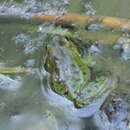Description
provided by AmphibiaWeb articles
Average body length for males about 74 mm and for females 83 mm. Shape typical of a green waterfrog, but with less distinct dorsolateral folds than in Rana ridibunda. Eyes closely set, long hind legs and vocal sacs at the corners of the mouth. In most frogs the back is uniformly green, often with a light green longitudinal middorsal stripe. Irregularly shaped dark green spots are randomly distributed over the back. In the loin area the flanks are yellowish. Dark transverse bands on the thighs continue onto the white underside. Vocal sacs of males are usually olive but turn dark gray to black in mating season (Noellert and Noellert 1992).
- author
- Arie van der Meijden
Distribution and Habitat
provided by AmphibiaWeb articles
Rana epeirotica is an endemic species of the Ionian geographic zone. It occurs throughout Western Greece, including the island of Kerkyra, and in Southern Albania. The species lives in all the lower parts of the main water-bodies of the area including a variety of biotopes, such as canals connected with rivers or lakes, swampy regions of lakes and large marshes, as well as calm riverbank waters. In Albania the species occurs also in lowlands (Sarante, Vrina and Vurlu plain). The species occurs from sea level up to 500 m. It is most common in lowlands (Gasc 1997).
- author
- Arie van der Meijden
Life History, Abundance, Activity, and Special Behaviors
provided by AmphibiaWeb articles
Rana epeirotica sometimes shares its habitat with R. ridibunda, with which it readily hybridizes. These mixed frog communities include 10 to 25% R. epeirotica and 5 to 15% of hybrids. Rana epeirotica differs in its flight behavior from R. ridibunda in that it flees onto the land instead of into the water when startled. The species calls at water temperatures from 13 to 24.5ºC. The call consists of up to 30 distinct pulses, lasting on average a total of 0.5 seconds. Pauses between calls last 0.5 to 0.9 seconds (Noellert and Noellert 1992).
- author
- Arie van der Meijden
Life History, Abundance, Activity, and Special Behaviors
provided by AmphibiaWeb articles
The species is common and quite abundant throughout its distributional range, but as it inhabits areas where human pressure is high, several populations are endangered. Beside pollution and habitat destruction, collecting of enormous numbers for commercial purpose is the main problem (Gasc 1997).
- author
- Arie van der Meijden
Epirus water frog
provided by wikipedia EN
The Epirus water frog (Pelophylax epeiroticus) is a species of frog in the family Ranidae. It is found in western Greece, including Kerkyra,[2][3][4] and the southern areas of Albania.[5] The species is collected from the wild for human consumption.
Description
Like most frogs, Epirus water frogs show sexual dimorphism. Males can grow to 2.9 inches (74 mm) in length, with females growing larger to 3.3 inches (84 mm). The dorsal side is typically green with irregular black spots. The underside is pale. Male vocal sacs are olive aside from mating season, when they can turn a dark gray.
Distribution and habitat
The species occurs in Mediterranean-type shrubby vegetation, rivers, swamps, freshwater lakes and marshes, and plantations. It is threatened by habitat loss, and is classified as vulnerable as populations within its relatively small range are fragmented.[1]
Reproductive behavior
The spawning period extends from the end of April to the beginning of May and can change by a few days depending on the latitude and altitude of a population and the local weather. In the case of high reproductive activity, calling begins in the morning at around 9 a.m. and lasts until midnight or longer with a longer break at dusk, during which the frogs are catching insects. Calling Epirus water frogs have been observed at water temperatures between 13 and 24.5 °Celsius.[2]
Mating call
The calls consist of very short pulses with intervals in between, which is why the calls sound creaky. According to the calculated equations, the calls last for 616 milliseconds at a water temperature of 15 °Celsius and consist of 32 pulses. As the temperature rises, the duration of the calls decreases, while the number of pulses per call increases. The frequency spectrum has a strong component between 1400 and 2400 Hertz. The males mostly give the calls in series.[2]
References
-
^ a b IUCN SSC Amphibian Specialist Group (2020). "Pelophylax epeiroticus". IUCN Red List of Threatened Species. 2020: e.T58592A89698408. doi:10.2305/IUCN.UK.2020-3.RLTS.T58592A89698408.en. Retrieved 16 November 2021.
-
^ a b c Schneider, H., Sofianidou, T. S., Kyriakopoulou-Sklavounou, P.: Bioacoustic and morphometric studies of water frogs (genus Rana) of Lake Ioannina in Greece, and description of a new species (Anura, Amphibia). In: Zeitschrift für zoologische Systematik und Evolutionsforschung. Volume 22, 1984, pp. 349–366.
-
^ Sofianidou, T. S., Schneider, H., Asimakopoulos, B.: Distribution of the water frog Rana epeirotica (Amphibia, Anura) in Greece. In: J. J. van Gelder, H. Strijbosch and P. J. M. Bergers (Eds.). Proceedings of the Fourth Ordinary General Meeting of the Societas Europaea Herpetologica, Nijmegen. 1987, pp. 365–367.
-
^ Sofianidou, T. S., Schneider, H.: Distribution range of the Epeirus Frog Rana epeirotica (Anura: Ranidae) and the composition of the water frog populations in western Greece. In: Zologischer Anzeiger. Volume 223, 1989, pp. 13–25.
-
^ Schneider, H., Haxhiu, I. (1992): The distribution of the Epeirus frog (Rana epeirotica) in Albania. In: Amphibia-Reptilia. Volume 13, 1992, pp. 293–295.

- license
- cc-by-sa-3.0
- copyright
- Wikipedia authors and editors
Epirus water frog: Brief Summary
provided by wikipedia EN
The Epirus water frog (Pelophylax epeiroticus) is a species of frog in the family Ranidae. It is found in western Greece, including Kerkyra, and the southern areas of Albania. The species is collected from the wild for human consumption.
- license
- cc-by-sa-3.0
- copyright
- Wikipedia authors and editors

